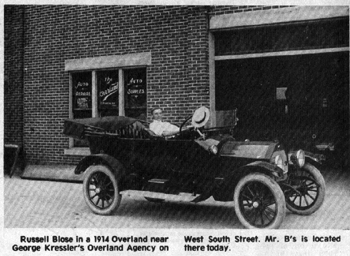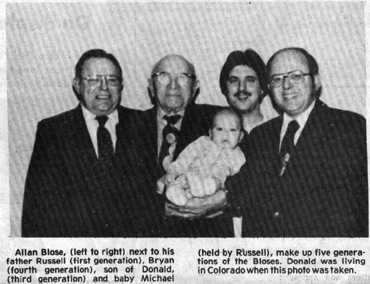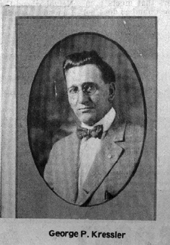April 23, 1981



Picture #1 – Russell Blose in a 1914 Overland near George Kressler’s Overland Agency on West South Street. Mr. B’s is located there today.
Picture #2 – Allan Blose (left to right) next to his father Russel (first generation), Bryan (fourth generation), son of Donald, (third generation) and baby Michael (held by Russell), make up five generations of the Bloses. Donald was living in Colorado when this photo was taken.
Picture #3 – George P. Kressler
Russell R. Blose, 315 College Ave., a 90 year-old Fostorian, wel-known in this community, has seen a lot of changes in the town since he came here November 1913, 68 years ago. “That was the year of the floods in Ohio”, Blose recalls.
At that time, Blose was living in Best Station, Lehigh County, Pennsylvania. His cousin, George Kressler, who will be remembered by older readers, had the Overland car agency in Fostoria, and wrote Blose to come to Fostoria and be a mechanic for him. He did just that, and that first job led to his association with the sale of cars and the filling station business for many years.
Later, Kressler sold his car agency to Charles Miniger, and Blose continued to work there. At that time, Kressler joined Allen Motor Co. The one accompanying photo shows Blose seated in an Overland car, parked in front of the car agent, which earlier was Miniger’s Livery Stable. The location was where Mr. B’s is today. At one time, Kressler had the K & W Oil Co. in that same location.
The Overland agency stayed on West South Street, from 1913 to 1922, then moved to East South, where Holman’s car agency is now. In 1929, Blose took over the Overland agency and moved to East Center St., where The Review Times parking lot is now and from there to North Main Street, where he was until 1937. His last place of business selling cars, was on East Tiffin Street, from 1937-1941, in the location where DeMarco’s is now.
In 1941, Blose started operating the Gulf Station at the corner of Union Elm and Perry streets, and continued there until 1963, at which time he retired to a small farm on South Main Street. During those latter years, Allan, his son, was associated with him. Ronald and Donald, grandsons of Blose recall handing around the gasoline station when they were kids.
Many readers will remember that the Blose gas station was known as Petunia Corner, because of the variety of flowers he grew in season to decorate the corner.
At 90, Russel Blose is still active…driving his own car about town, going to church and doing his own shopping. Mrs. Blose died in 1977.
Recently, five generations of Bloses gathered at his home for a visit. They are shown in one of the accompanying photos. Ronald, a twin to Donald lives in Denver, Colorado, and was not present for the group photo.
According to Donald, when “grandpa” Blose came to their house, which is at 332 College Ave., his wife plays the piano and they have a family “sing” with grandpa joining in. He likes to sing `Silent Night’ in German.
Mr. Blose enjoys visitors from old friends and customers. What’s more important to senior citizens?
READER FEEDBACK: MORE IWO JIMA
Mrs. Allen Holman, Glenview Drive, a loyal Potluck reader, remembered reading the November 1980 article about the Iwo Jima flag-raising. Then vacationing in Florida, she saw an article in the Orlando Sentinel Star, which described a special event, honoring a Florida veteran who died in that war. She saved the paper and brought it back to me.
According to the article, Ernest “boots” Thomas was a Marine who lived in a small farm town near Tallahassee, Fla., and was killed in action, after being part of the group who stormed Mt. Surabachi and raised the first American flag there.
On Sunday, Feb. 22, 1981, 300 friends, veterans and family of Ernest Thomas, gathered in the small cemetery where a simple marker show his grave. But, on that day they dedicated a nine-foot high marble recreation of the flag raising…built with $12,000 of their own money, in memory of a hometown boy.
That’s real loyalty and sacrifice.
Thomas’ sister, present for the ceremony, said, “It’s the culmination of a dream, it’s finally come true”.
Thank you Mrs. Holman – for your thoughtfulness.
PRESBYTERIAN STORY
A number of out-of-town folks who either take the RT or received copies from friends responded with letters.
Frank Longfellow, Lighthouse Point, Fla., wrote “We received the RT articles and copy of your talk that you gave at the 125th anniversary dinner at the church. I wish we could have been there”.
“In reading your talk, you told about Clyde Wilcox’s being married in the Manse. We were married in the Manse too, on a Sunday night after church, July 21, 1918, by Rev. Wilbur Cliff Shuman and Dot Plotner, who were later married, stood up with us. The next morning, I left for Great Lakes to serve in World War I”.
“Six years later, our baby died and Rev. McDowell had the funeral. During World War II, we lost our oldest son, Robert. We were living in Frankfort, Ind., at that time. We brought his back to Fostoria and he is buried in Fountain Cemetery. Rev. Wilson officiated at his funeral at the Harrold Funeral Home. All three of our children were baptized in the Fostoria Presbyterian Church. The Church has many memories”.
Dorothy (Leonard) Ellis wrote from Ocala, Fla.: “Corrine Speck sent me the clippings from the RT, about the 125th anniversary of the Presbyterian Church. I belonged to that church, grew up there, was baptized there, played the old organ for a number of years. Left there in 1925 to come to Ocala to teach music in the schools and am still here”.
“There are still some of us old Presbyterians living: Dorothy (Crawford) McCarty, daughter of James Crawford, an elder; Lucille (Mahoney) Romig, her father was J.F. Mahoney, an elder; Mildred (Mickey) Hutchinson”.
“I’m glad they left the arches in the sanctuary. I used to try to count the bulbs in them but always went to sleep trying”.
“Graduated from FHS in 1916…so the football teams and Jack Wainwright’s band are still pleasant memories. By the way, Mary Allen Gayle, daughter of E.W. still lives in Hattieburg, Miss. She is Dr. Gayle, Deam of Women at the college there, although she is now retired”.
“Thank you for this pleasant journey down memory lane”.
Mrs. Howard Turner, a regular reader of the RT and Potluck wrote: “It was very thoughtful of you to send your talk to me. I did enjoy reading it and wish I could have been there in person”.
“I was wondering if the Kaubisch family shouldn’t have been mentioned in some way as they did the upstairs Sunday school room over, took down the sliding doors, put in new furniture, carpet, etc.”
“The article about the Fostoria High Car was interesting. I was timekeeper there after I graduated (my first position). I have a picture of the car and the office girls in it”.
“Thanks again for the information. I do enjoy your column”.
Gewen Young, daughter of Mr. and Mrs. Howard Turner, also wrote:
“We both enjoyed reading about the anniversary of the church. I remember our Sunday School classes – 1945-49, when we had a Sunday School orchestra – Jim, Tom and George Gray, Jim Guernsey, Sue Bates, Bartunek, and I played piano. It was lots of fun. Barbara Fruth was our girls-class teacher one year and we thought she was wonderful. She was a senior in high school then. that was long ago. I teach seventh and eighth grade Sunday School boys and girls.
“I enjoyed reading about Edna Hatfield. She was principal at Crocker Street School when I was there. We really had some great teachers – Miss. McCormick, Miss Bourquin, Miss Eger, Miss Whiteman, Mr. Siekeres, Miss Moss – we were lucky to have them”.
“Continued success with your column – you are doing a great service to the community”.
DILLINGER STORY
After that story was published, The Bowling Green Sentinel thought it was a good idea to do a story about it too, especially since Ruth Harris Davidson is now a resident there. She, along with Bill Daub were hostages.
Also, Floyd Harrison, West Tiffin Street, who was an employee of the bank at that time, just recently came forward with more information about the robbery which was heretofore unpublished.
Harrison’s office was on the Mezzanine, along with B.M. Solomon and secretary Lucille Culyer. The latter happened to look down into the bank area and saw the bandits in command. She immediately returned to her desk and telephoned the Highway Patrol, and that is the reason they arrived before the bandits escaped, but it was impossible to be effective with their gunfire because of bystanders.
Harrison also divulged that VanMeter, one of the bandits, had “cased” the upstairs offices prior to the holdup, posing as a telephone installer, opening drawers with the purpose of detecting guns, and, making comment about where to install another phone. Harrison asked Solomon about the additional phone later, and it was then that the plot was understood.
Grace Miller, another bank employee was forced to go into the vault with one of the bandits to get the money, according to Harrison.
EVENBECK PROFILE
The profile about Scott appeared in Potluck on Feb. 12, 1981. Here is a letter from him:
Dear Paul – “I appreciate your sending me copies of the article. I am humbled by all the attention and appreciate your thoughtfulness very much”.
“I don’t know if you’ve ever read the biography of Quinn (The Man from New York). Though I don’t presume to compare myself with him and all his accomplishments. I have always resented the off-hand and un-complimentary things he said in describing Fostoria, his hometown too”.
“It’s a good town for growing up, for having friends, for having roots. The education people of my generation received at FHS was the best. I was happy with the teachers I had while I was in school, was happier still when I compared the preparation I had had with that of others at the University and, on reflection now believe that we had a very special group of teachers”.
“As I mentioned to you earlier, my hobby is local and family history. I hope that you will be able to collect your writing in a volume or two one of these days. It is important for the community to have a record of where it’s been so it will know where it is”.
ST. WENDELIN STORY
In the second installment of that story, there was a copy error, which the author did not detect before publication. The article indicated that the new high school was conceived in 1929, under Rev. Burger. It should have said 1926, which was prior to Burger’s death. The new school was dedicated in 1931. Several readers called the error to my attention.